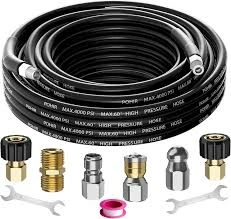Effective Techniques for Using Sewer Cleaning Hoses in Plumbing Maintenance
Understanding Sewer Cleaning Hoses Essential Tools for Maintenance
Sewer systems play a crucial role in maintaining the hygiene and sanitation of urban environments. However, over time, these systems can become clogged with debris, grease, and other materials that hinder their functionality. To combat these issues, professionals in plumbing and maintenance often rely on specialized equipment such as sewer cleaning hoses. Understanding the importance, types, and usage of these hoses can help ensure efficient sewer maintenance.
The Importance of Sewer Cleaning Hoses
Sewer cleaning hoses are integral to the process of maintaining and clearing sewer lines. They are designed to deliver water at high pressure to dislodge blockages and clean the internal walls of pipes. Regular maintenance with these hoses can prevent serious plumbing problems, such as backups and overflows, which can lead to costly repairs and health hazards for residents. Moreover, maintaining clear sewer lines ensures that waste is effectively transported and processed, contributing to the overall hygiene of urban areas.
Types of Sewer Cleaning Hoses
There are various types of sewer cleaning hoses available, each designed for specific applications. The most common types include
1. High-Pressure Cleaning Hoses These hoses are constructed to withstand extremely high pressures, usually ranging from 2,000 to 4,000 PSI. They are suitable for heavy-duty cleaning tasks, capable of breaking up tough clogs caused by tree roots or accumulated grease.
2. Jetting Hoses Jetting hoses are specifically designed for use with hydro jetting machines. These systems propel water at high velocities to clear blockages. Jetting hoses come in various diameters and lengths, allowing flexibility in tackling various sewage systems.
3. Flexible Hoses Flexible sewer cleaning hoses allow for easier maneuverability in tight or curved spaces. Their adaptability makes them ideal for complex sewer systems with numerous bends and turns.
4. Reinforced Hoses These hoses have an additional layer of material, usually synthetic fibers, to increase durability and pressure resistance. They are particularly useful in industrial applications where high stress is common.
Choosing the Right Hose
When selecting a sewer cleaning hose, several factors must be considered
sewer cleaning hose

- Diameter The diameter should match the specifications of the sewer system being serviced. Standard sizes typically range from 1/2 inch to several inches, depending on the application.
- Length Longer hoses allow for greater reach, particularly in large sewer systems. However, it’s vital to ensure that the hose can handle the pressure and is not too cumbersome to manage.
- Material High-quality materials, such as polyurethane or rubber, provide flexibility and durability. It's essential to choose a hose that can withstand harsh chemicals and abrasives often found in sewage.
- Pressure Rating Determine the required pressure for the specific jobs to ensure that the hose can handle the necessary water pressure without bursting or causing leaks.
How to Use Sewer Cleaning Hoses Safely
Using sewer cleaning hoses requires careful consideration to ensure safety and effectiveness
1. Wear Protective Gear Always wear gloves, goggles, and appropriate clothing when operating sewer cleaning equipment to protect against hazardous materials.
2. Inspect the Hose Before use, inspect the hose for any signs of damage, such as cracks or leaks. A damaged hose can lead to pressure loss and unsafe conditions.
3. Follow Manual Guidelines Adhere to the manufacturer’s instructions regarding pressure settings and usage to avoid accidents and equipment failure.
4. Maintain Equipment Regular maintenance of both the hose and jetting equipment ensures longevity and reliable performance.
Conclusion
Sewer cleaning hoses are vital tools for maintaining the functionality and safety of sewer systems. By understanding the different types of hoses available and knowing how to use them effectively, plumbing professionals can significantly improve the efficiency of sewer maintenance operations. Prevention of blockages not only saves costs in the long run but also contributes to a healthier urban environment. Whether it’s a routine maintenance operation or an emergency call for service, having the right sewer cleaning hose on hand is essential for success in plumbing and waste management.
-
Ultimate Spiral Protection for Hoses & CablesNewsJun.26,2025
-
The Ultimate Quick-Connect Solutions for Every NeedNewsJun.26,2025
-
SAE J1401 Brake Hose: Reliable Choice for Safe BrakingNewsJun.26,2025
-
Reliable J2064 A/C Hoses for Real-World Cooling NeedsNewsJun.26,2025
-
Heavy-Duty Sewer Jetting Hoses Built to LastNewsJun.26,2025
-
Fix Power Steering Tube Leaks Fast – Durable & Affordable SolutionNewsJun.26,2025

